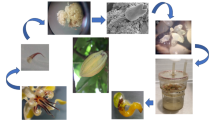Abstract
Shoots of Paulownia tomentosa Steud., the Empress tree, were regenerated from cultured hypocotyl segments. The phenotypic and ploidy status of a population of regenerated trees was investigated and compared with a control population of trees grown from seed. Five of the six measured phenotypic characteristics were not significantly different between both populations of plants. Twenty of twenty-one shoots had the normal diploid chromosome number and one was apparently mixoploid. Five phenotypic variants were recovered, including a variegated variant that appearsr to be a plastid chimera undergoing a segregation of normal and mutant plastids. The variegated variant was the only stable variant. All other variants displayed typical morphology in their second year of growth. Precocious flowering of five regenerated plantlets occurred in their first year of growth. These plants were derived from different hypocotyls and did not flower the subsequent year.
Similar content being viewed by others
References
Bartlett MS (1937) Properties of sufficiency and statistical tests. Proc Roy Soc A 160:268–82
Burk LG, Stewart RN, Dermen H (1964) Histogenesis and genetics of a plastid-controlled chlorophyll variegation in tobacco. Amer J Bot 51:713–724
Dirr MA (1975) Manual of Woody Landscape Plants. Stipes Pub. Co., Champaign, Illinois
Fan Mei Lei, Hu Ta-Wel (1976) Plantlets from Paulownia tissue cultures. Bulletin No. 286. Taiwan Forestry Research Institute, 6 pp
Horak J, Lustinec J, Mesicek J, Kaminek M, Polackova D (1975) Regeneration of diploid and polyploid plants from the stem pitch explants of diploid marrow stem kale (Brassica olereacea L.). Ann Bot 39:571–577
Kirk JTO, Tilney-Basset RAE (1978) The Plastids: Their Chemistry, Structure, Growth and Inheritance. Elsevier/North Holland Biomedical Press
Larkin PJ, Scowcroft WR (1981) Somaclonal variation — a novel source of variability from cell cultures for plant improvement. Theor Appl Genet 60:197–214
Marcotrigiano M, Stimart DP (1983) In vitro organogenesis and shoot proliferation of Paulownia tomentosa Steud. (Empress Tree). Plant Sci Lett 31:303–310
McKeand SE (1985) Expression of mature characteristics by tissue culture plantlets derived from embryos of loblolly pine. J Amer Soc Hort Sci 110:619–623
Murashige T, Skoog F (1962) A revised medium for rapid growth and bioassays with tobacco tissue cultures. Physiol Plant 15:473–497
Reisch B (1983) Genetic variability in regenerated plants. In: Evans DA, Sharp WR, Ammirato PV, Yamada Y (eds) Handbook of Plant Cell Culture. 1. Techniques for Propagation and Breeding. Macmillan Publishing Co., New York, pp 748–769
Rufner R, Barker AV (1984) Ultrastructure of zinc-induced iron deficiency in mesophyll chloroplasts of spinach and tomato. J Amer Soc Hort Sci 109:164–168.
Satina S, Blakeslee AF, Avery AG (1940) Demonstration of the three germ layers in the shoot apex of Datura by means of induced polyploidy in periclinal chimeras. Amer J Bot 27:895–905
Stearns JL (1944) Paulownia as a tree for commerce. Am For 52: 60–61, 95–96
Swartz HJ, Galletta GJ, Zimmerman RH (1981) Field performance and phenotypic stability of tissue culture propagated strawberries. J Amer Soc Hort Sci 106:667–673
Tang RC, Carpenter SB, Wittwer RF, Graves DH (1980) Paulownia — a crop tree for wood products and reclamation of surface — mined land. Southern J Appl For 4:19–24
Vaughn KC, Wilson KG (1980) A dominant plastome mutation in Hosta. J Hered 71:203–206
Westfall JJ (1949) Cytological and embryological evidences for the reclassification of Paulownia. Amer J Bot 36:805 (Abstract)
Author information
Authors and Affiliations
Rights and permissions
About this article
Cite this article
Jagannathan, L., Marcotrigiano, M. Phenotypic and ploidy status of Paulownia tomentosa trees regenerated from cultured hypocotyls. Plant Cell Tiss Organ Cult 7, 227–236 (1986). https://doi.org/10.1007/BF00037739
Received:
Revised:
Accepted:
Issue Date:
DOI: https://doi.org/10.1007/BF00037739




